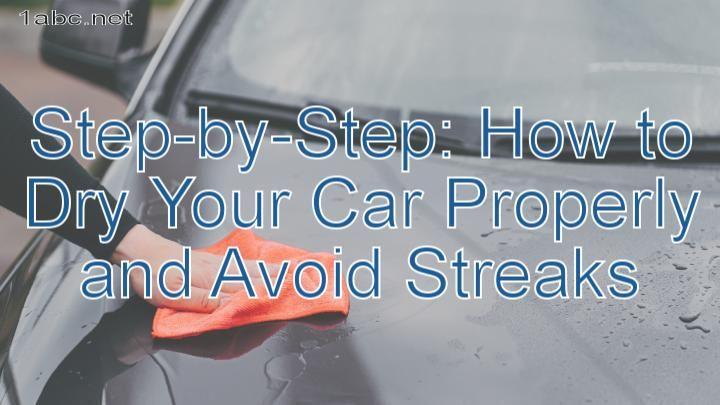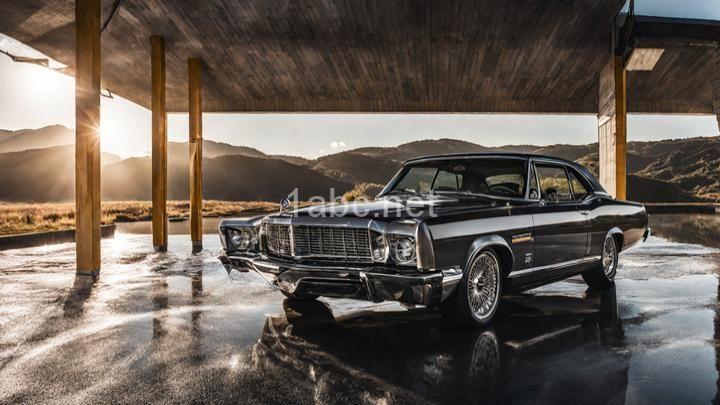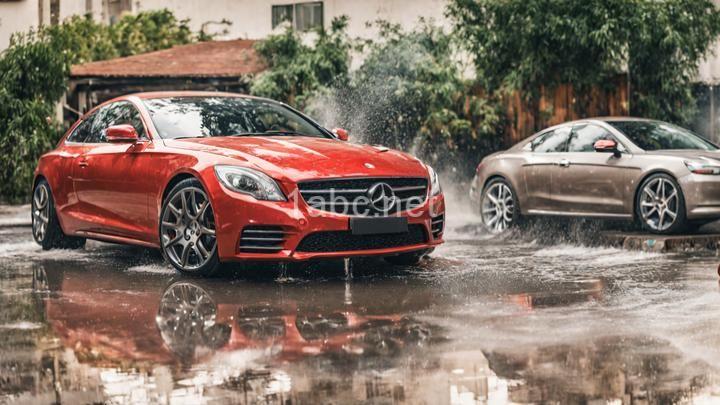Step-by-Step: How to Dry Your Car Properly and Avoid Streaks
Introduction:
Step 1: Gather the Necessary Supplies
Step 2: Remove Excess Water
Step 3: Start from Top to Bottom
Step 4: Use Proper Drying Techniques
Step 5: Utilize a Drying Aid (Optional)
Step 6: Pay Attention to Detail
Step 7: Check for Streaks or Water Spots
Step 8: Maintain a Regular Drying Routine
Conclusion:

Introduction:
Welcome to our friendly guide on how to dry your car properly without leaving behind any streaks. We understand that maintaining the appearance of your car is important to you, and drying it correctly is a crucial step in achieving that polished, showroom-worthy look. In this step-by-step tutorial, we'll walk you through the process so that your car shines like new. Let's get started!
Step 1: Gather the Necessary Supplies
Before you begin drying your car, it's important to gather all the necessary supplies. Having everything ready will streamline the process and ensure that you have the right tools at your disposal. You will need microfiber towels, a drying aid (optional), and a drying mitt. Microfiber towels are highly absorbent and won't cause any scratches on your vehicle's surface. A drying aid, such as a spray-on product, can further enhance the drying process by reducing water spots and adding a protective layer. Lastly, a drying mitt provides an efficient and effective way to dry larger areas of your car.
Step 2: Remove Excess Water
To avoid streaks, it's essential to remove excess water from your car's surface before drying. Leaving standing water to air dry can result in water spots and streaks. You can use a gentle stream of water from a hose or even a leaf blower to blow off excess water. Be sure to start from the top of the vehicle and work your way down, directing the water flow away from the gaps and crevices where water might accumulate.
Step 3: Start from Top to Bottom
When it comes to drying your car, always start from the top and work your way down. This ensures that any water or dirt from higher areas will not be dragged onto lower panels. Begin by drying the roof, followed by the windows, doors, and finally, the lower body panels. This systematic approach will help you achieve a streak-free finish.
Step 4: Use Proper Drying Techniques
When drying your car, it's important to use the proper techniques to minimize the risk of streaks. Use a clean microfiber towel and employ either a patting or dragging motion to remove the water. Patting involves gently pressing the towel against the surface to absorb the water, while dragging involves dragging the towel across the surface. Whichever technique you choose, remember to apply gentle pressure and avoid excessive rubbing, as this can introduce fine scratches.
Step 5: Utilize a Drying Aid (Optional)
Using a drying aid is an optional step that can further enhance the drying process. A drying aid is a product specifically designed to reduce water spots and add a protective layer to your car's surface. If you choose to use a drying aid, follow the instructions on the product label and apply it after you have removed the excess water. This additional step can help achieve an even more pristine finish.
Step 6: Pay Attention to Detail
During the drying process, it's crucial to pay attention to detail and not overlook areas that tend to retain water. These often include side mirrors, door handles, and other recessed areas. Take the time to thoroughly dry these areas using a drying mitt or a smaller microfiber towel. Neglecting these spots can result in water spots and streaks, detracting from the overall appearance of your car.
Step 7: Check for Streaks or Water Spots
Once you have completed drying your car, it's important to inspect it for any remaining streaks or water spots. Take a few moments to examine the surface under proper lighting conditions. If you notice any imperfections, use a clean microfiber towel or a detailing spray to gently remove them. Pay attention to any areas where water might have pooled, such as around the side mirrors or in the crevices of the grille.
Step 8: Maintain a Regular Drying Routine
To keep your car looking its best and prevent water damage, it's important to establish a regular drying routine. Depending on your circumstances, this could mean drying your car after each wash or every few days. By maintaining a routine, you'll prevent water spots, streaks, and mineral deposits from forming on your vehicle's surface. Additionally, regular drying helps to preserve the paint and prevent oxidation, prolonging the overall lifespan of your car's appearance.
Conclusion:
Congratulations on successfully learning how to dry your car properly without streaks! By following these step-by-step instructions and utilizing the right tools and techniques, you can achieve a streak-free, shiny finish every time. Remember to gather all the necessary supplies, remove excess water, start from top to bottom, use proper drying techniques, consider using a drying aid, pay attention to detail, check for streaks or water spots, and maintain a regular drying routine. By putting your new knowledge into practice, you'll enjoy a pristine, showroom-worthy car that turns heads wherever you go. Happy drying!
FREQUENTLY ASKED QUESTIONS
What is the best method to dry my car without leaving streaks?
To dry your car without leaving streaks, follow these steps:
- Start by rinsing the car with clean water to remove any loose dirt or debris.
- Use a high-quality microfiber drying towel or chamois specifically designed for drying cars. These are designed to absorb water effectively without leaving streaks.
- Begin drying your car from the top down. Start with the roof, then move to the windows, hood, trunk, and finally the sides.
- Use gentle, sweeping motions to blot the water rather than rubbing or dragging the towel across the surface. This helps to prevent any potential scratching.
- As the towel becomes saturated with water, wring it out thoroughly or switch to a dry towel to prevent streaks.
- Pay extra attention to areas that tend to collect water, such as the door handles, mirrors, and crevices. Make sure to dry these areas properly to prevent water spots.
- If you notice any remaining streaks or water spots, use a detail spray or quick detailer to lightly mist the affected area, and gently wipe with a clean microfiber towel.
- Finally, open the doors, trunk, and hood to dry any water trapped in these areas that may cause streaks if left to air dry.
Following these steps should help you dry your car effectively and achieve a streak-free finish.
Can I use a regular towel to dry my car?
Using a regular towel to dry your car is not recommended. Regular towels, such as bath towels or dish towels, are not designed specifically for automotive use and may not be as effective or safe for drying your car's exterior. They can leave behind lint, swirl marks, or scratches on your car's paint.
Instead, it is advisable to use a microfiber towel specifically designed for drying cars. Microfiber towels have fine fibers that are highly absorbent and gentle on your car's surface. They help to efficiently soak up water without causing any damage or leaving behind debris. Using a proper drying towel can help you achieve a streak-free and spotless finish while protecting your car's paint.
How long does it usually take to dry a car properly?
The time it takes to properly dry a car can vary depending on a few factors such as the weather conditions, the size of the vehicle, and the drying method used. On average, it may take about 10-15 minutes to dry a car thoroughly using a microfiber drying towel or a leaf blower. It's important to ensure that all surfaces, including the windows, mirrors, and crevices, are completely dry to prevent water spots and streaks.
What are the benefits of properly drying my car?
Properly drying your car after washing it comes with several benefits:
- Prevents water spots: Drying your car helps to prevent water spots from forming on the paintwork. Water spots are caused by minerals and impurities in the water that can get left behind when the water evaporates. By drying your car thoroughly, you minimize the chance of these spots forming.
- Preserves the paintwork: Drying your car's surface helps to protect the paintwork from potential damage. Water droplets left on the surface can act as magnifying glasses, intensifying the sunlight and heat, which can lead to paint fading or even damage.
- Reduces the risk of rust: By eliminating excess moisture from the surface, drying your car helps to prevent the formation of rust. This is particularly important for the metal components, as prolonged exposure to moisture can cause them to corrode over time.
- Enhances the shine: By removing any remaining water droplets, you can achieve a streak-free finish and enhance the appearance of your car's paint. This allows the natural shine to come through, giving your car a polished and well-maintained look.
Overall, properly drying your car not only preserves its appearance but also helps to maintain its overall condition and extend its lifespan.
Is it necessary to dry my car after every wash?
Drying your car after every wash is not absolutely necessary, but it is highly recommended. Here are a few reasons why drying your car is beneficial:
- Prevents water spots: When water droplets are left on the surface of your car and allowed to air dry, they can leave behind unsightly water spots. These spots are particularly evident on dark-colored cars and can be difficult to remove.
- Minimizes mineral deposits: Tap water often contains minerals that can leave residue on your car's surface if not dried properly. This residue can accumulate over time and diminish the appearance of your vehicle.
- Reduces the risk of mold and mildew: If water gets trapped in crevices or seams of your car, it can create a breeding ground for mold and mildew. Drying your car thoroughly helps prevent the growth of these organisms.
- Maintains a polished look: Drying your car after washing helps to maintain a polished and reflective appearance. This is especially important if you have applied wax or sealant to protect your car's paintwork.
To dry your car effectively, you can use a soft and absorbent microfiber towel or a specialized drying cloth. Start from the top and work your way down, ensuring that you dry all the surfaces thoroughly.
By taking a few extra minutes to dry your car after each wash, you can help preserve its condition and keep it looking its best.
How can I prevent water spots from forming on my car's surface?
To prevent water spots from forming on your car's surface, you can follow these tips:
- Wash your car regularly: Regular washing helps remove dirt, minerals, and other contaminants that can contribute to water spot formation.
- Use a high-quality car wash soap: Using a specialized car wash soap helps prevent residue and soap scum, which can lead to water spots.
- Dry your car thoroughly: After washing your car, use a microfiber drying towel or a chamois to remove excess water. Be sure to dry all surfaces, including windows, mirrors, and trim.
- Avoid washing your car in direct sunlight: Washing your car in direct sunlight can cause water to evaporate quickly, leaving behind mineral deposits that can lead to water spots. Try to wash your car in a shaded area or during cooler times of the day.
- Use a water softener or a spot-free rinse system: These systems can help remove minerals from the water and prevent the formation of water spots.
- Apply a protective wax or sealant: Using a wax or sealant can create a barrier on your car's surface, making it harder for water spots to adhere.
- Use a waterless car wash product: Waterless car wash products allow you to clean your car without using water, minimizing the risk of water spot formation.
By following these tips, you can help keep your car's surface free from water spots.
Should I apply any products or treatments after drying my car?
Yes, it is recommended to apply certain products or treatments after drying your car to protect and maintain its appearance. Here are a few options:
- Waxing: Applying wax to your car's surface can help protect the paint from the elements and add a glossy shine. It also serves as a barrier against dirt, water spots, and UV rays. Use a high-quality car wax and follow the instructions for application.
- Sealants: Sealants are similar to wax but provide longer-lasting protection. They create a barrier on the paint that helps to repel dirt, grime, and UV rays. Applying a sealant can help maintain a glossy finish and extend the life of your car's paintwork.
- Ceramic Coatings: These coatings provide superior protection and durability compared to wax or sealants. Ceramic coatings create a protective layer on the paint surface, making it resistant to scratches, chemicals, UV rays, and other contaminants. They can provide long-lasting shine and make regular cleaning easier.
- Quick Detailer: A quick detailer is a spray-on product that helps to enhance the gloss and shine of your car's paint. It also adds a layer of protection between regular washes and can be used to remove light dust, fingerprints, or smudges.
Remember to read the instructions and use these products as directed. It's also recommended to apply them in shaded areas and on a clean and dry car.
Can I use a car wash drying aid to help with the drying process?
Yes, using a car wash drying aid can be helpful in the drying process after washing your car. Drying aids are specifically formulated products designed to aid in the drying process by providing additional lubrication and increasing water sheeting action. They help to reduce water spots and streaks, and can also enhance the shine of your vehicle. When applied properly, a drying aid can make the drying process easier and more efficient.
Is it safe to dry my car in direct sunlight?
Drying your car in direct sunlight is generally not recommended as it can lead to several issues. When water droplets on your car evaporate too quickly in the sun, they can leave behind water spots and streaks. Additionally, the heat from the sun can cause the water to dry unevenly, potentially leading to the formation of hard-to-remove water spots. To avoid this, it is best to dry your car in a shaded area or during cooler parts of the day.




